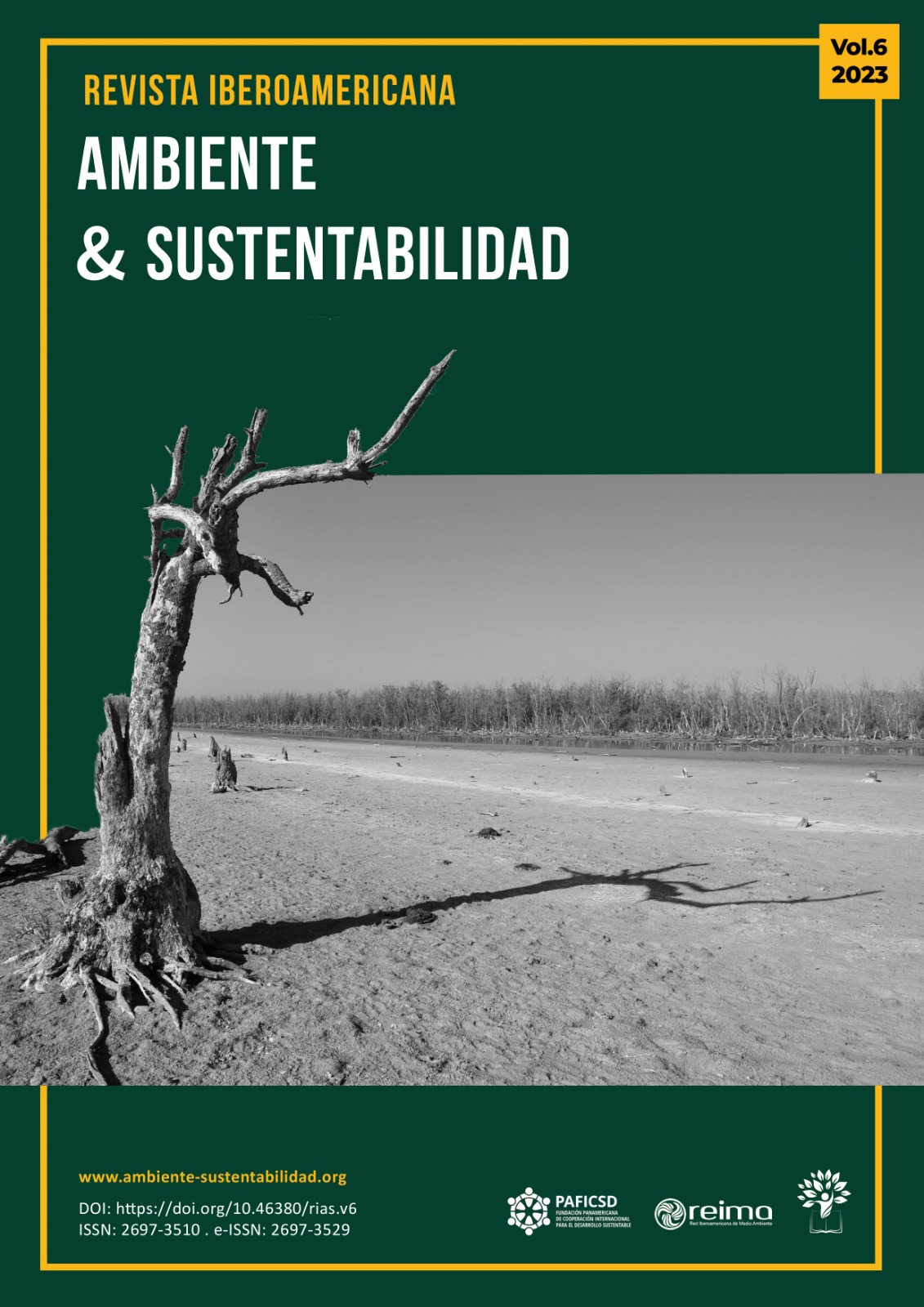Phytoremediation with Eichhornia crassipes in wastewater from the Jipijapa canton, Ecuador
DOI:
https://doi.org/10.46380/rias.vol6.e221Keywords:
aquatic plants, bioassay, bioremediation, water treatmentAbstract
Wastewater is an environmental problem that threatens aquatic and terrestrial ecosystems, so the objective of the research was to carry out a phytoremediation test with aquatic plants in wastewater from the Jipijapa canton treatment plant. The methodology used consisted of an experiment where three Eichhornia crassipes plants from an area with high population density were put to the test; these plants went through an acclimatization process and then were subjected to effluent water from the treatment plant for nine days. Before and after starting the bioassay, the parameters of pH, electrical conductivity, turbidity, color, and odor
were analyzed. Physicochemical tests resulted in an acidic pH of 5.5, conductivity of 156.0 S/cm, turbidity of 49.8%, dark brown coloration, and bad odor of the water before starting the study. After nine days the parameters were pH of 8.17, conductivity of 256.4 S/cm, turbidity of 4.71%, colorless with solids and odorless. The results obtained corroborated the problem with the water from the residual treatment plant and the phytoremediation capacity of E. crassipes; which can be a friendly solution to the environment in the treatment of wastewater.
Downloads
Metrics
References
Atoche, J. (2016). Planta de tratamiento de aguas residuales para reuso de riego de parques y jardines en el distrito de Víctor Larco Herrera. Provincia de Trujillo. La Libertad [Tesis de grado, Universidad Privada Antenor Orrego]. UPAO. Repositorio institucional. https://bit.ly/41E78WM
Barceló, L. D. y López, M. J. (2008). Contaminación y calidad química del agua: el problema de los contaminantes emergentes [Presentación]. Panel científico-técnico de seguimiento de la política de aguas de la Fundación Nueva Cultura del Agua, Sevilla, España. https://bit.ly/2Pw7cpn
Camargo, L. X. (2021). Evaluación de la carga contaminante de la quebrada Garzón por la descarga directa de aguas residuales de la red de alcantarillado del casco urbano del municipio de Garzón [Tesis de grado, Universidad Católica de Colombia]. UCC Repositorio institucional. https://bit.ly/3mINUzy
Delgado, G. F. (2020). Evaluación del bio-tratamiento de fluidos residuales de la empresa laboratorio portugal S.R.L mediante la “Eichornia crassipes” (buchón de agua) para la remoción de elementos ecotóxicos (cromo, arsénico y cadmio) y materia orgánica [Tesis de grado, Universidad Nacional de San Agustín de Arequipa]. UNSAA Repositorio institucional. https://bit.ly/3J5L0vY
Elenwo, E. y Akankali, J. (2017). The Estimation of Potential Yield of Water Hyacinth: A Tool for Environmental Management and an Economic Resource for the Niger Delta Region. Journal of Sustainable Development Studies, 9(2), 115-137. https://bit.ly/438d8bl
García, E. F. y Sánchez, D. S. (2022). Eficiencia de Fitorremediación por Chrysopogon zizanioides y Eichhornia crassipes para el tratamiento de aguas grises domésticas en Cantoral, Ica 2022 [Tesis de grado, Universidad César Vallejo]. UCV Repositorio institucional. https://bit.ly/3Ld7nSQ
Gonzáles, J. y Ramírez, E. (2021). Implementación de la Eichhornia crassipes, como alternativa biorremediadora en el tratamiento de aguas residuales en el cantón El Pangui – Ecuador. En R. Abreu-Naranjo, R. Alemán-Pérez y C. Bravo-Medina (Eds.) Primer congreso gestión ambiental y conservación de la biodiversidad (pp. 333-346). Universidad Estatal Amazónica. https://bit.ly/3YER2JI
Guevara, M. y Ramírez, L. (2015). Eichhornia crassipes, su invasividad y potencial fitorremediador. La Granja, 22(2), 5-11. https://bit.ly/3ZWspcB
Lu, B., Xu, Z., Li, J. y Chai, X. (2018). Removal of water nutrients by different aquatic plant species: An alternative way to remediate polluted rural rivers. Ecological engineering, 110, 18-26. https://doi.org/10.1016/j.ecoleng.2017.09.016
Mendoza, G. (2018). La Calidad del agua de la subcuenca río Jipijapa y su utilización para riego en el valle de Joa [Tesis de grado, Universidad Estatal del Sur de Manabí]. UNESUM Repositorio institucional. https://bit.ly/3FdvmxM
Ministerio del Ambiente de Ecuador. (2013). Revisión y actualización de la Norma de Calidad Ambiental y de Descarga de Efluentes: Recurso Agua. https://bit.ly/3yvPdV8
Priya, E. y Selvan, P. (2017). Water hyacinth (Eichhornia crassipes) - an efficient and economic adsorbent for textile effluent treatment - A review. Arabian Journal of Chemistry, 10(2), S3548–S3558. https://doi.org/10.1016/j.arabjc.2014.03.002
Wani, R., Ganai, B., Shah, M. y Uqab, B. (2017). Heavy metal uptake potential of aquatic plants through phytoremediation technique - A review. Journal of Bioremediat & Biodegrad, 8(4), 404. https://doi.org/10.4172/2155-6199.1000404
Zhou, X., Wang, G. y Yang, F. (2017). Characteristics of growth, nutrient uptake, purification effect of Ipomoea aquatica, Lolium multiflorum, and Sorghum sudanense grown under different nitrogen levels. Desalination, 273(2-3), 366-374. https://doi.org/10.1016/j.desal.2011.01.057
Published
How to Cite
Issue
Section
License
Copyright (c) 2023 Bryan Duran Mera, Margarita Jesús Lino García

This work is licensed under a Creative Commons Attribution-NonCommercial-ShareAlike 4.0 International License.
This work is licensed under a Creative Commons Attribution-NonCommercial-ShareAlike 4.0 International License (CC BY-NC-SA 4.0)
© This license allows users to distribute, remix, adapt, and build upon the material in any medium or format, provided that attribution is granted to the creator.














